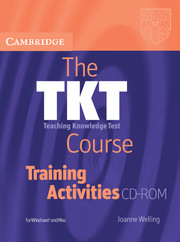1.7 - Learning styles match
Published online by Cambridge University Press: 09 February 2024
Summary
Instructions
1. Divide the class into groups of four. Hand out a set of learning styles cards to each group. Have each group match each learning style to its definition.
2. Check answers as a whole group.
3. Explain that you are going to give each group another set of cards with activities described on them. Explain that for each activity the students should make a note of which learning style(s) the activity would be suitable for. Have one student in each group make notes.
4. When the groups have finished, have trainees walk around the classroom looking at the other groups’ answers and noticing any differences.
5. Lead feedback on any discrepancies and different choices. To give trainees a written record, hand out a copy of the complete worksheet (1.7B) for them to note the answers on.
6. Have trainees identify their own learning styles by placing their finger(s) on the card(s) which they most identify with. Ask a couple of volunteers to explain their choices, e.g. I’m a visual learner as I need to see words and phrases written down before I can memorise and use them, but I also learn well in groups. I lose motivation if I have to study too much on my own!
7. Finally, elicit which learning style this activity most appeals to (visual, group).
Answer key
Learning styles
visual learners: students who learn well through seeing auditory learners: students who learn well through hearing kinaesthetic learners: students who learn well when moving their bodies group learners: students who learn well working with other people individual learners: students who learn well when working alone reflective learners: students who learn well by thinking things through impulsive learners: students who learn well by reacting quickly
Activities and learning styles
A. group
B. group, auditory, impulsive
C. auditory, impulsive
D. reflective, group
E. visual, reflective, group
F. individual, visual, reflective
G. visual, impulsive
H. impulsive, kinaesthetic, auditory
I. individual, auditory
J. reflective, individual
K. individual, visual
L. reflective, visual, individual
M. kinaesthetic, group, impulsive
N. auditory, visual, individual
O. kinaesthetic, auditory, group
P. kinaesthetic, auditory
- Type
- Chapter
- Information
- The TKT Course Training Activities , pp. 30 - 32Publisher: Cambridge University PressFirst published in: 2024

